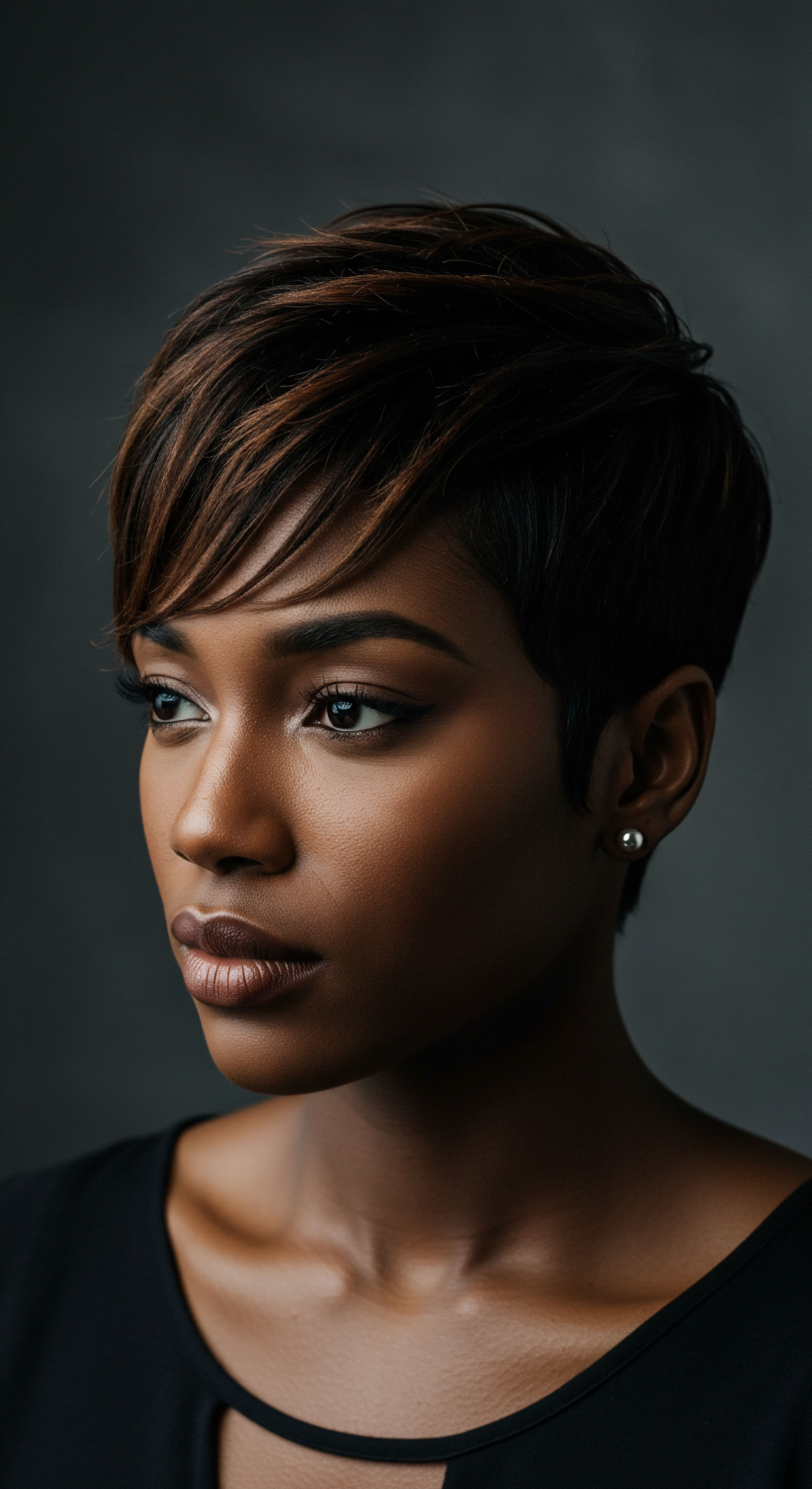
Roots
There exists a quiet, deeply personal conversation that unfolds each night, as the world settles into slumber and stars emerge. This hushed dialogue takes place between individuals and their hair, a ritual passed down through generations, often without explicit instruction. It is a moment of care, a gentle tending that reaches beyond mere aesthetics, connecting us to something ancient and profound.
This nightly communion with our strands holds echoes of cultural heritage, a silent testament to the enduring significance hair carries across human history. It is a practice steeped in ancestral wisdom, a continuation of traditions that speak to identity, protection, and belonging.
Consider the earliest whisperings of hair’s importance. Across various civilizations, hair was seldom viewed as a simple biological outgrowth. Instead, it was often regarded as a potent symbol, a conduit for spiritual energy, a marker of social standing, or a protective shield.
The way hair was dressed, adorned, or preserved carried messages, some overt, others whispered only to those who understood the deeper meanings. These practices, particularly those enacted under the cloak of night, suggest a deliberate intention ❉ to safeguard not only the physical strands but also the spirit and legacy they represented.

Hair’s Ancient Stories
From the sprawling empires of antiquity to the vibrant communities of indigenous peoples, hair has held a singular place in human expression. Ancient African kingdoms, for instance, held textured hair in high esteem. Its coiled patterns and unique structure were not simply biological attributes; they were integral to identity, status, and societal roles.
Hairstyles became an art form, a canvas depicting an individual’s journey from birth to significant life events, and even into the realm of the ancestors. The preparation for sleep, a time of vulnerability and renewal, naturally became a period for tending to this sacred aspect of self.
In many cultures, the act of preparing hair for the night was more than a chore; it was a ritual of preservation. This preservation extended beyond preventing tangles or breakage. It was about maintaining the integrity of one’s visual identity, a connection to community, and a quiet act of self-reverence. The tools used, the oils applied, the very movements of the hands, all carried weight, imbued with generations of accumulated knowledge and purpose.

The Scalp’s Silent Wisdom
Beneath the visible hair lies the scalp, a living landscape often overlooked in daily routines. Yet, the scalp is the very foundation from which our hair grows, a complex ecosystem of follicles, blood vessels, and nerve endings. Understanding its physiology is paramount to comprehending how night rituals support hair health.
During sleep, our bodies enter a state of repair and regeneration. This nocturnal period is when cellular turnover accelerates, and various physiological processes, including hormone production and stress management, find their rhythm.
The scalp benefits immensely from this nightly rejuvenation. Blood circulation, vital for delivering nutrients and oxygen to hair follicles, is optimized during restful periods. Hormones like melatonin, often associated with sleep, also play a part in regulating hair follicle activity.
Thus, a night of peaceful slumber, combined with deliberate scalp care, creates an optimal environment for hair growth and resilience. Neglecting this foundational aspect can disrupt the hair growth cycle, leading to concerns like increased shedding or thinning.

Cultural Significance of Nighttime Care
The quiet moments before sleep, dedicated to hair, often carry layers of cultural meaning. For many Black women, these rituals are a direct link to a past where hair was a site of both oppression and resistance. During periods of enslavement, head coverings, including bonnets, were weaponized to dehumanize, yet simultaneously transformed into a means of coded communication and cultural expression. Post-slavery, the bonnet remained a practical tool for preserving styles and protecting delicate textures, evolving into a symbol of defiance and self-possession.
Night hair rituals serve as a profound, often unspoken, connection to cultural identity and ancestral wisdom, preserving not only strands but also stories.
This duality of experience, where an object of control transforms into an emblem of freedom, speaks volumes about the enduring spirit of communities. The nightly wrapping of hair, the careful placement of a bonnet, becomes a continuation of this legacy, a quiet act of honoring those who came before. It is a moment to affirm identity, to protect what is uniquely one’s own, and to prepare for the day ahead with hair that feels cared for and respected.

Anatomy of Textured Hair
Textured hair, encompassing a wide spectrum of curls, coils, and waves, possesses a unique anatomical structure that informs its care. Unlike straight hair, the follicle of textured hair is often elliptical or flattened, causing the hair shaft to grow in a helical or spiraled pattern. This distinct shape results in more cuticle layers being exposed at the curves of the hair shaft, making it naturally more susceptible to moisture loss and breakage if not properly tended.
Understanding these structural differences is paramount for effective nighttime care. The natural curvature means that oils produced by the scalp do not easily travel down the entire length of the hair shaft, leaving the ends particularly vulnerable to dryness. This inherent characteristic necessitates targeted hydration and protective measures, especially during periods of rest when friction against bedding can further compromise the delicate strands.
- Follicle Shape ❉ The unique elliptical or flattened shape of the follicle in textured hair creates its characteristic curl pattern.
- Cuticle Exposure ❉ The bends and turns of coiled strands mean more cuticle layers are exposed, increasing susceptibility to moisture loss.
- Oil Distribution ❉ Natural scalp oils struggle to travel down the full length of a coiled hair shaft, making ends prone to dryness.
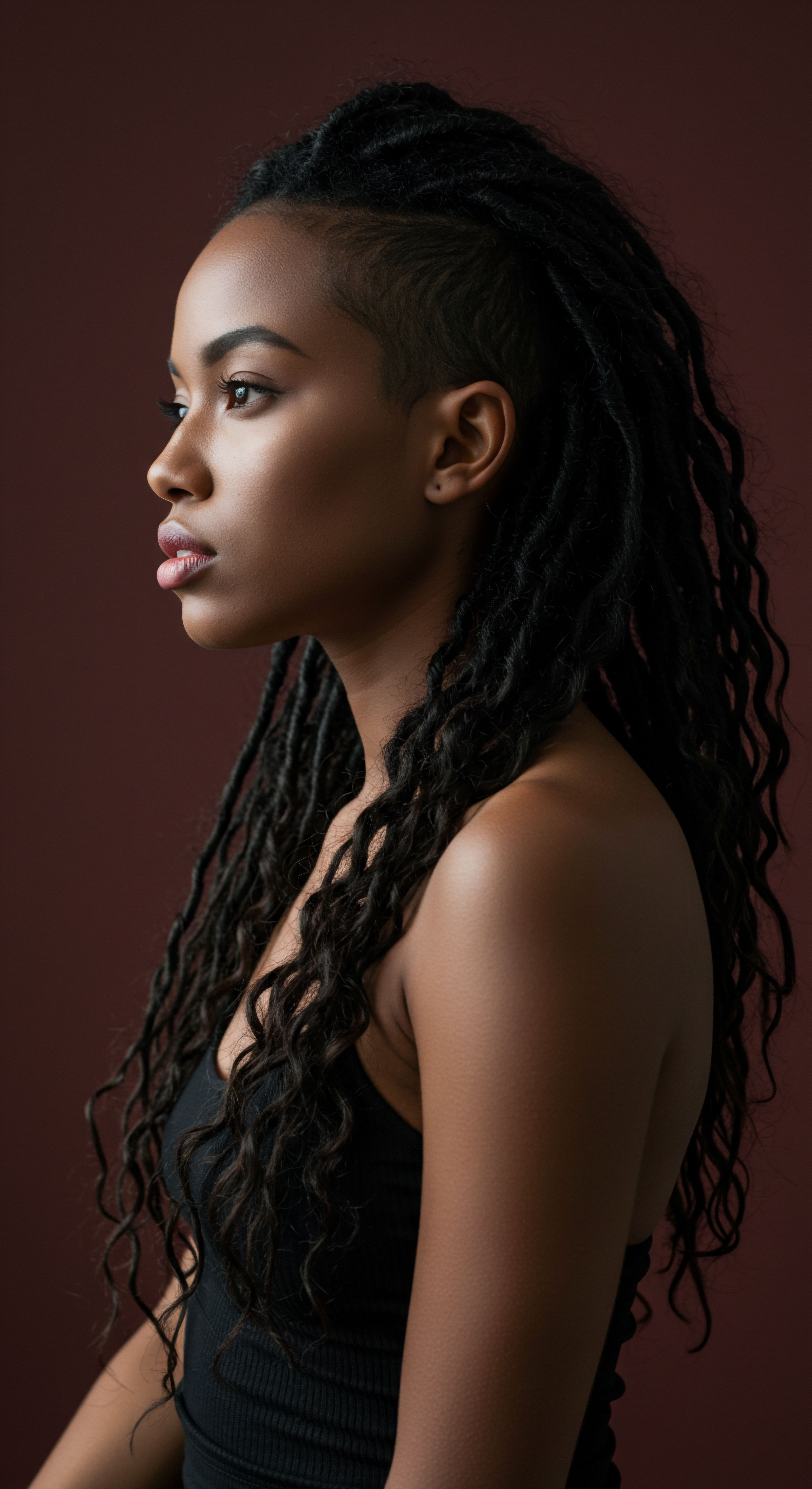
Growth Cycles and Ancestral Rhythms
Hair growth follows a cyclical pattern, moving through anagen (growth), catagen (transition), and telogen (resting) phases. These cycles are influenced by various factors, including genetics, nutrition, and overall well-being. Nighttime, a period of reduced external stimuli and physiological repair, plays a quiet yet significant part in supporting the anagen phase, where active cell division occurs in the hair follicle.
While scientific understanding of hair growth cycles is relatively modern, ancient cultures intuitively understood the rhythms of nature and the human body. Many traditional practices, including those performed at night, aligned with these rhythms, seeking to promote health and vitality through consistent, gentle care. The wisdom of these practices, passed through generations, reflects an ancestral understanding of how to support the hair’s natural inclination to thrive, even if the precise biological mechanisms were not then known. It is a beautiful convergence of inherited wisdom and contemporary scientific validation, affirming the deep connection between our daily routines and the enduring vitality of our hair.

Ritual
As the day recedes and shadows lengthen, a distinct shift occurs in the rhythm of life. For many, this transition signals the beginning of a thoughtful engagement with personal care, a time when practical wisdom concerning hair finds its daily expression. This is where the foundational knowledge of hair’s structure and cultural meaning meets the applied art of its preservation.
The routines we undertake as night descends are more than mere habits; they are purposeful acts, often steeped in techniques refined over centuries, aimed at maintaining health and integrity. Let us step into this space of shared, practical knowledge, where gentle guidance shapes our nightly hair practices.
The evening hours present unique challenges and opportunities for hair care. During sleep, hair is vulnerable to friction against bedding, moisture loss, and tangling. Nighttime rituals are thus designed to counteract these potential stressors, providing a protective cocoon that safeguards the strands until morning. This proactive approach to care is a hallmark of traditions that value hair as a precious aspect of identity and beauty.

The Art of Preparation for Rest
Preparing hair for rest is an art form, a series of deliberate steps that contribute to its well-being. This might involve detangling with a wide-tooth comb, working gently from ends to roots to prevent unnecessary stress on the hair shaft. For textured hair, this step is particularly vital, as its natural curl patterns can easily form knots if not carefully managed.
Following detangling, moisture application often plays a central role. Lightweight oils or hydrating leave-in conditioners can be applied to seal in moisture, creating a barrier against the drying effects of the air and absorbent pillowcases. This practice, often rooted in traditional knowledge, speaks to an understanding of hair’s thirst and the need to quench it consistently.

Protective Styling Through the Ages
The concept of protective styling at night is far from new; it is a practice with deep historical roots, particularly within communities with textured hair. These styles minimize manipulation and exposure to environmental elements, guarding against breakage and promoting length retention.
Consider the long lineage of styles like braids, twists, and locs. These are not merely fashion statements; they are functional forms of protection, passed down through generations. In African cultures, braids date back to 3500 BC, serving not only as identifiers of social status and kinship but also as practical means to manage and preserve hair. At night, these styles become a quiet shield, allowing hair to rest undisturbed.
Even simpler acts, like gathering hair into a loose bun or a pineapple on top of the head, serve a similar purpose in modern contexts. They reduce friction, prevent tangling, and maintain the integrity of the daytime style, extending its life and reducing the need for excessive manipulation.

Tools and Their Timeless Purpose
The implements used in nightly hair rituals are often simple yet profoundly effective, carrying with them the legacy of generations. The most iconic among these for textured hair is perhaps the bonnet or headwrap. Historically, these coverings were worn by European women for warmth in the mid-1800s, but they also held significant cultural meaning in African regions, known as dukus or doeks.
The nightly act of safeguarding hair, whether through careful braiding or donning a protective bonnet, is a quiet act of self-care and cultural continuity.
For Black communities, bonnets and headwraps became indispensable tools for preserving hair, particularly delicate textures prone to friction and moisture loss. Modern bonnets, often crafted from silk or satin, continue this tradition, providing a smooth surface that allows hair to glide, preventing friction, breakage, and moisture evaporation. The selection of these materials is a testament to an evolving understanding of hair science, yet it builds upon a timeless wisdom of protection.
| Tool Silk Bonnet |
| Primary Benefit Reduces friction, preserves moisture, prevents tangling |
| Historical Context Evolved from traditional headwraps used in African cultures for protection and identity. |
| Tool Satin Pillowcase |
| Primary Benefit Minimizes friction, gentle on hair cuticles |
| Historical Context Modern adaptation of traditional smooth coverings, building on the need to protect hair during sleep. |
| Tool Wide-Tooth Comb |
| Primary Benefit Gentle detangling, reduces breakage |
| Historical Context Reflects ancient practices of using natural materials for hair separation, adapted for modern hair care. |

Ingredient Choices for Nightly Nourishment
The selection of ingredients for nightly hair care speaks volumes about cultural preferences and available resources. Across various traditions, natural oils and butters have been prized for their conditioning and protective properties. Coconut oil, shea butter, argan oil, and various herbal infusions have long been used to nourish hair and scalp, often applied before bedtime to allow for deep penetration overnight.
These traditional ingredients are now often validated by contemporary science, which recognizes their beneficial fatty acids, vitamins, and antioxidants. The move towards natural and organic products in the wider hair care market reflects a growing consumer awareness, often echoing the wisdom of ancestral practices that prioritized plant-based remedies. This confluence of old and new knowledge strengthens the argument for consistent, ingredient-conscious nightly care.

The Psychology of a Nightly Routine
Beyond the physical benefits, night hair rituals hold a quiet psychological weight. The consistency of a routine provides a sense of order and control, qualities that contribute to overall well-being. For many, these moments of self-tending serve as a calming transition from the demands of the day to the tranquility of sleep.
The act of caring for one’s hair can also be a deeply grounding experience, a connection to the self and to a lineage of care. As Dr. Afiya Mbilishaka, an expert on Black hair and mental health, suggests, “We bond with other Black people through hair and create community through the grooming process to fortify us in places that see our hair as a deficit.” This communal aspect, even in a solitary nightly ritual, brings a sense of belonging and worth, echoing the intergenerational connections forged over shared hair experiences. It is a practice that transcends mere grooming, becoming a quiet affirmation of identity and resilience.
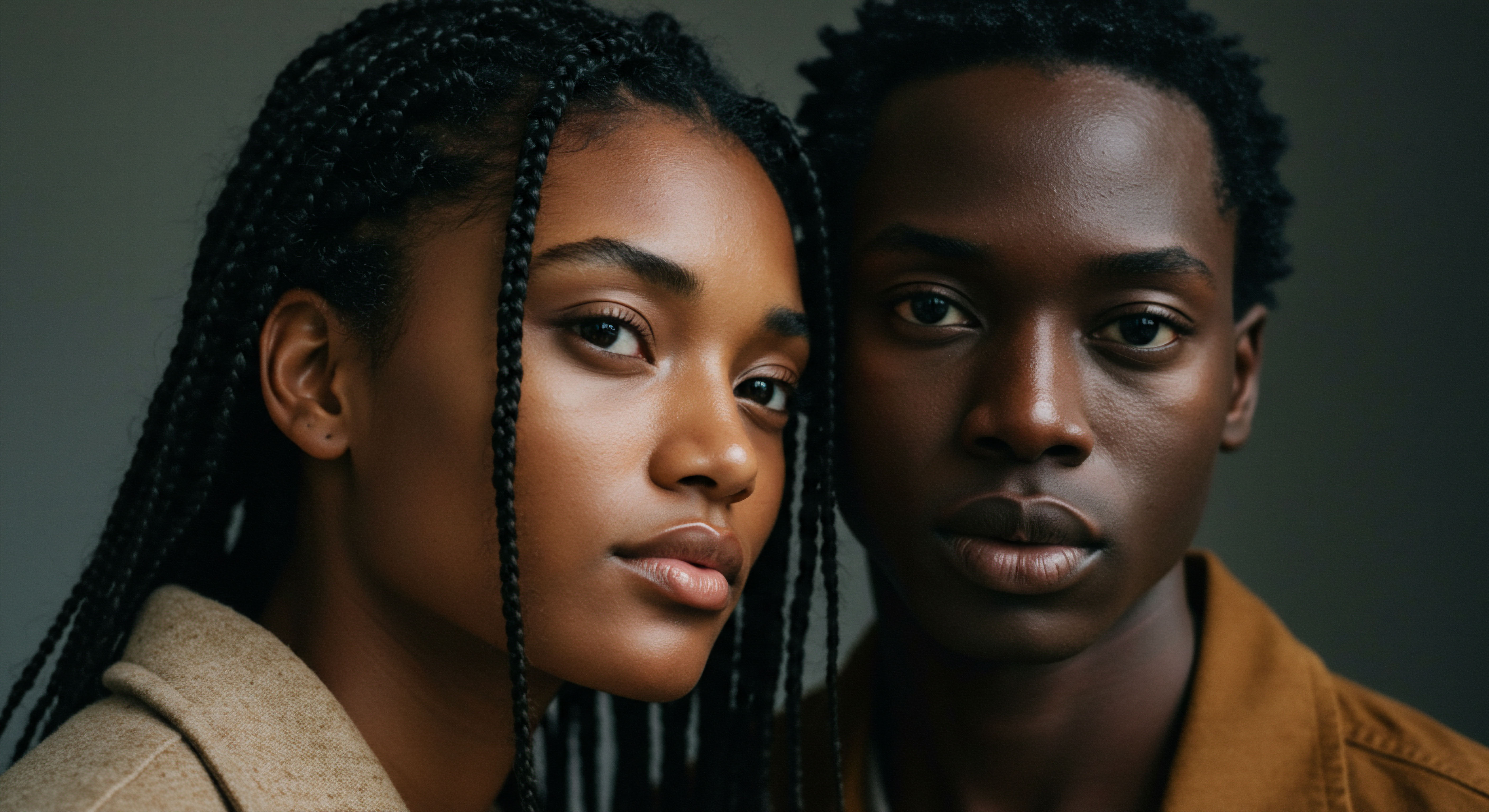
Relay
What profound insights emerge when we consider night hair rituals not as isolated acts, but as complex expressions at the crossroads of biology, sociology, and economic reality? The quiet moments before sleep, dedicated to our strands, unearth layers of meaning, inviting us to look beyond the visible and into the intricate interplay of forces that shape our practices. This section will explore the deeper currents, drawing connections between the science of rest, the societal shifts influencing hair care, and the often-unseen economic dimensions that underpin these deeply personal traditions.
Our exploration moves from the tactile experience of care to the broader systems that influence it. Understanding the biological imperatives of hair renewal during sleep, alongside the historical and contemporary societal pressures on hair presentation, allows for a more complete picture. We also must consider the economic currents that shape access to products and services, revealing a complex web of influences.

The Science of Sleep and Hair Renewal
The adage of “beauty sleep” holds a deeper scientific truth for hair. During our nightly rest, the body orchestrates a symphony of repair and regeneration, a process vital for hair health. Research indicates a significant connection between sleep quality and the vitality of our hair. A 2022 study revealed a strong link between severe alopecia areata, a condition causing patchy hair loss, and sleep issues, including insufficient sleep (less than six hours) and elevated stress levels.
This connection is rooted in physiological mechanisms. Sleep deprivation can disrupt the hair growth cycle, prematurely shifting follicles from their active growth phase (anagen) into a resting phase (telogen), leading to increased shedding. Moreover, inadequate sleep elevates cortisol, a stress hormone known to interfere with hair growth cycles.
Melatonin, often associated with sleep regulation, also plays a part in hair follicle activity. Thus, a restful night is not merely about feeling refreshed; it is a biological imperative for robust hair renewal, with deep implications for the efficacy of any night hair ritual.

Societal Shifts and Hair Practices
Hair practices, including those performed at night, are rarely static; they are in constant dialogue with broader societal currents. The natural hair movement, for example, represents a significant shift, challenging Eurocentric beauty standards that historically favored chemically straightened hair. This movement has propelled a resurgence of Afrocentric styles and practices, influencing nightly routines that prioritize the preservation of natural curl patterns.
The choice to wear natural hair, and the care routines that accompany it, is a powerful statement of identity and cultural reclamation. This has spurred innovations in product development, yet also highlights persistent societal biases. Even as acceptance grows, individuals with textured hair still confront discrimination in professional and social settings based on their hairstyles. This enduring pressure reinforces the significance of protective night rituals, not just for hair health, but as a quiet act of resistance and self-affirmation against a world that often seeks to diminish natural forms.

Global Perspectives on Night Hair Care
Night hair rituals are not confined to a single cultural group; variations appear across the globe, each reflecting unique environmental conditions, hair types, and cultural beliefs. In some Asian cultures, for instance, traditional and herbal ingredients hold significant value in hair care, with rituals deeply rooted in historical practices influencing product choices. These traditions often emphasize long-term scalp health and hair vitality through consistent, gentle application of natural remedies before sleep.
Conversely, in Western contexts, the emphasis might lean towards convenience and product efficacy, sometimes overlooking the ritualistic or cultural aspects. The global marketplace now presents a fascinating blend, where ancient practices meet modern formulations, allowing for a cross-pollination of ideas. However, the underlying principle remains ❉ the quiet hours of the night offer a unique window for focused hair care, whether guided by ancient wisdom or contemporary science.
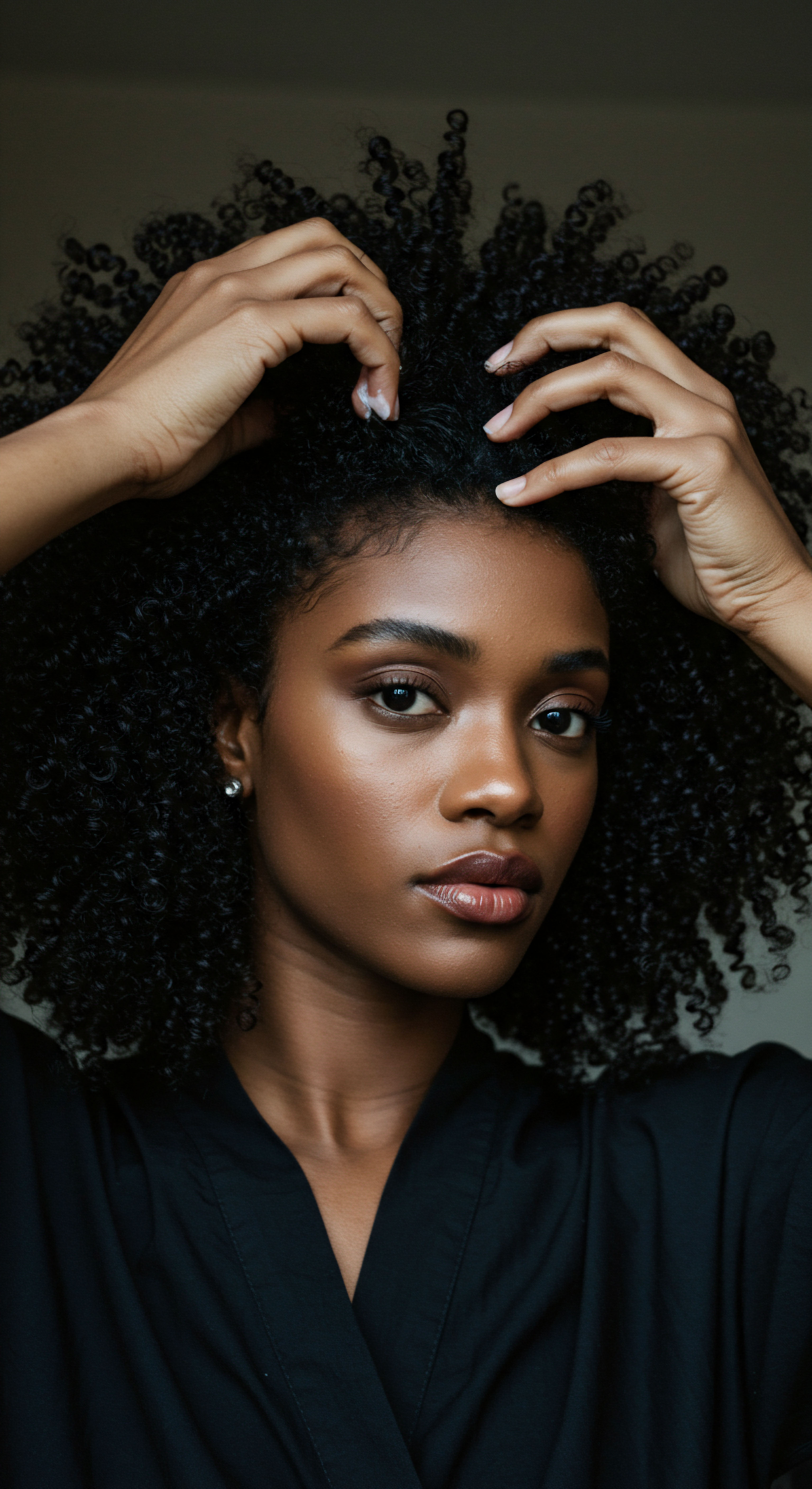
Intergenerational Knowledge Transfer
How does knowledge about night hair rituals travel across generations?
The transmission of night hair rituals often occurs through observation, direct instruction, and shared experience within families. A mother teaching her daughter how to braid her hair for bed, a grandmother sharing the secrets of a particular oil application, or siblings learning from each other in shared living spaces—these are the intimate conduits of cultural continuity. This informal education is profoundly impactful, carrying not only practical techniques but also the unspoken values, stories, and sense of identity associated with hair care.
This intergenerational exchange is a living archive, preserving methods that might otherwise be lost. It grounds individuals in their heritage, fostering a sense of belonging and shared experience. The communal aspect of hair grooming, even when performed individually at night, reinforces these bonds, creating a collective memory of care and connection.

The Economic Dimensions of Hair Rituals
The realm of night hair rituals, while personal, exists within a larger economic landscape, particularly for those with textured hair. The global Black hair care market, a significant segment of the beauty industry, is projected to reach approximately USD 4.9 billion by 2033, growing from USD 3.2 billion in 2023. This growth underscores a substantial consumer base with specific needs and preferences.
Yet, beneath these figures lies a less visible economic reality ❉ a disparity in pricing. Research suggests that products formulated for coily and curly hair types often bear a higher price tag than those for straight hair. A study examining haircare products found a significant difference in average price per ounce, with products for coily/curly hair being more expensive.
For one leading US manufacturer, coily/curly hair products were priced at approximately $0.66 per ounce, while straight hair products from the same manufacturer were around $0.46 per ounce. This difference, sometimes referred to as a “minority hair tax,” means that the economic burden of maintaining natural, textured hair can be considerably higher.
| Hair Type Category Coily/Curly Hair Products |
| Average Price Per Ounce $0.66 ± $0.05 |
| Hair Type Category Straight Hair Products |
| Average Price Per Ounce $0.46 ± $0.04 |
| Hair Type Category This data indicates a statistically significant price difference (P < 0.0134) for one leading US manufacturer, highlighting a potential economic disparity in hair care. |
This economic reality shapes night hair rituals. It influences product choices, encourages DIY solutions, and reinforces the value placed on effective, long-lasting protective styles. The higher cost of specialized products makes the nightly investment in care even more critical, as it extends the life of styles and minimizes the need for frequent, costly interventions. The economic dimension, therefore, is not a peripheral concern; it is deeply interwoven with the cultural and personal practices of nighttime hair care, demanding a conscious approach to product selection and routine consistency.
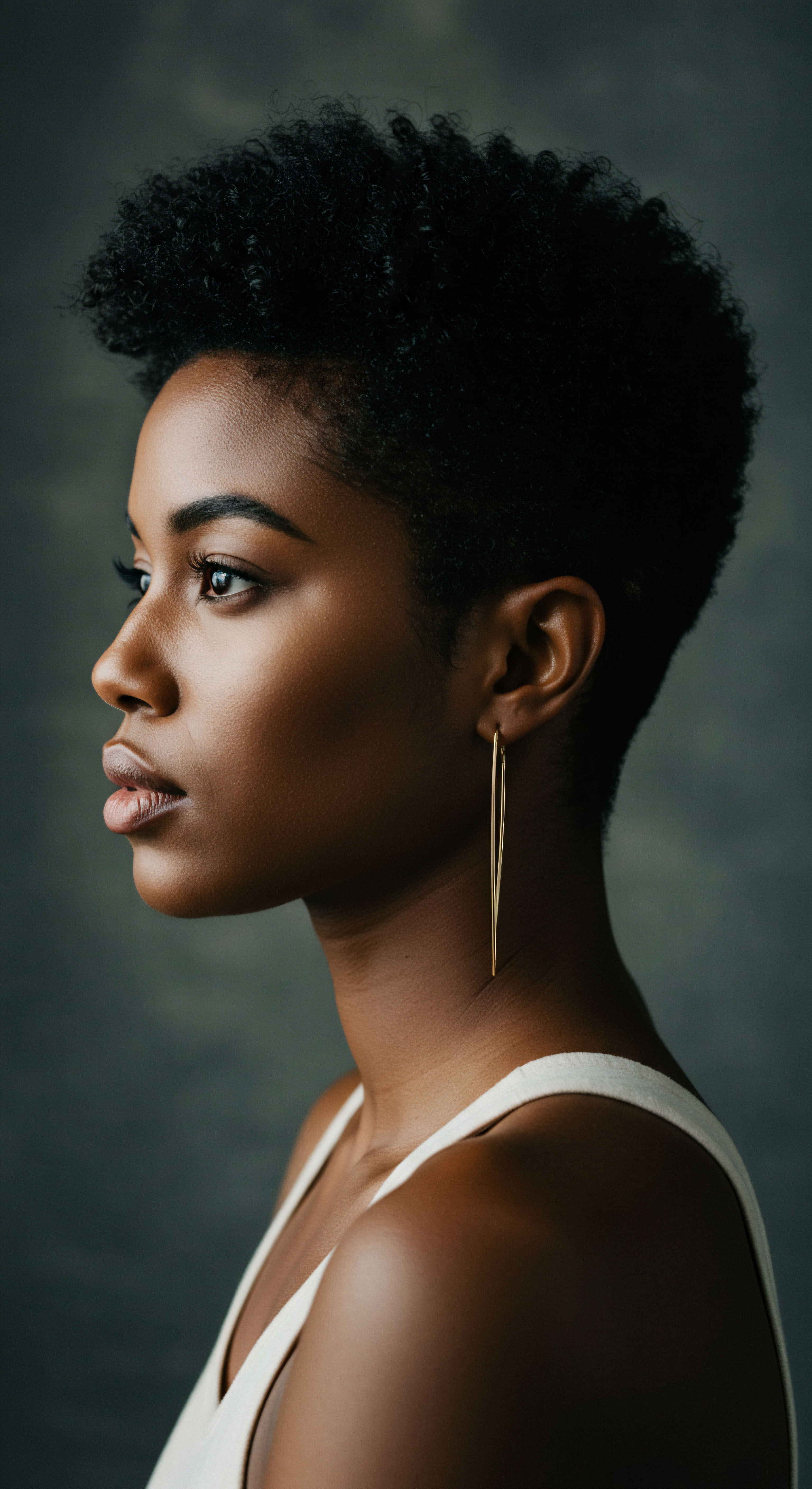
How Do Modern Innovations Shape Ancient Practices?
The landscape of hair care is ever-evolving, with new scientific discoveries and technological advancements constantly emerging. How do these modern innovations interact with and reshape the ancient practices of night hair rituals? From advanced ingredient formulations to smart fabrics for protective coverings, contemporary science offers tools that can augment traditional methods.
For example, understanding hair porosity and protein balance, backed by scientific research, allows for more targeted product selection for nightly deep conditioning. The development of specialized silk and satin blends for bonnets and pillowcases, informed by textile science, offers superior friction reduction and moisture retention compared to earlier materials. These advancements do not necessarily replace ancestral practices; rather, they provide enhanced means to achieve the same timeless goals of protection and nourishment. The integration of science with tradition allows for more effective, personalized care, ensuring that the wisdom of the past continues to serve the needs of the present.
- Ingredient Science ❉ Advanced cosmetic chemistry creates formulations that better address specific needs of textured hair, like moisture retention and protein strengthening, optimizing nightly treatments.
- Textile Technology ❉ Innovations in fabric, such as higher-grade silk and satin, improve the efficacy of protective head coverings, reducing friction and preserving hair hydration during sleep.
- Diagnostic Tools ❉ Modern tools and techniques for assessing hair and scalp health (e.g. microscopic analysis, digital scalp scans) provide precise insights, guiding more effective nightly care regimens.

Reflection
The quiet world of night hair rituals, often performed in solitude, reveals itself as a profound connection to something far grander than individual habit. It is a dialogue with heritage, a testament to resilience, and a living chronicle of cultural identity. Each gentle brushstroke, each careful twist, each silken wrap, carries the weight of generations, whispering stories of survival, beauty, and self-possession.
These practices, grounded in both ancestral wisdom and emerging scientific understanding, affirm the enduring power of care, not merely for our physical strands, but for the very essence of who we are. They invite us to slow down, to listen to the quiet rhythms of our bodies, and to honor the deep, abiding legacy that resides within each curl, coil, and wave, preparing us not just for the day ahead, but for a continued connection to our roots.

References
- Byrd, A. & Tharps, L. (2001). Hair Story ❉ Untangling the Roots of Black Hair in America. St. Martin’s Press.
- Jacobs-Huey, L. (2007). From the Kitchen to the Parlor ❉ Language and Becoming in African American Women’s Hair Care. Oxford University Press.
- Lashley, M. (2020). The importance of hair in the identity of Black people. Nouvelles pratiques sociales, 31(2), 183-199.
- Mbilishaka, A. (2018). PsychoHairapy ❉ Using Hair as an Entry Point into Black Women’s Spiritual and Mental Health. Journal of Black Psychology, 44(8), 701-723.
- Lee, S. Y. & Lee, W. S. (2022). Association between sleep quality and hair loss ❉ A cross-sectional study. Annals of Dermatology, 34(2), 125-131.
- Smith, L. E. et al. (2022). Price Differences in Haircare Products by Hair Texture. Journal of the American Academy of Dermatology, 87(3), 675-676.
- Bae, J. M. & Kim, H. S. (2022). The association between perceived stress, sleep quality, and hair and scalp health ❉ A cross-sectional study. Journal of Cosmetic Dermatology, 21(11), 5874-5879.
- Thompson, C. (2019). Hair ❉ A Cultural History of African American Women’s Hair. Bloomsbury Academic.
- Mintel Group Ltd. (2023). US Black Haircare Market Report.
- Business Research Insights. (2024). Black Hair Care Market Growth Analysis.